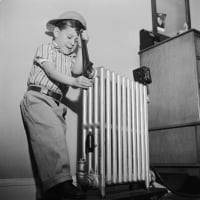Tips or Tricks for draining Amtrol Boilermate coil?

How much fluid(system is 85% water and ~15% glycol) should I expect out of an 40 Gallon Amtrol boiler mate? Replacing the unit, because it is leaking slightly and 20 years old.
Comments
-
Is it possible at the manifold to push air in there and flush fluid out there also?
D0 -
Well, the manifold is right behind the tank. So I think it would be difficult to get back there to cut the pipe to push air. Once the tank is out of the way it would be easyDZoro said:Is it possible at the manifold to push air in there and flush fluid out there also?
D !
!
I am going to add a drain in the replacement.
0 -
-
If that is on a 2nd floor, wouldn't code require a pan for the water heater and the boiler?0
-
And where are the relief valves draining?mattmia2 said:If that is on a 2nd floor, wouldn't code require a pan for the water heater and the boiler?
There was an error rendering this rich post.
0 -
You could have a crescent or pipe wrench on the copper female adaptor ready to turn the 90 elbow sideways immediately after you loosen the union, so that it ejects fluid into a pan. There shouldn't be that much fluid in the coil.0
-
No idea why there is glycol in it. I will take it with my truck antifreeze flush and fill and pay to have it disposed? If that is not ok then let me know.STEVEusaPA said:Why glycol and how do you intend to dispose of it.
On the new install, pipe in some drain valves, and stick it on a pan.
I am going to put 1 drain on boiler return which on the HTP is the lower of the 2. Should be good I hope.
edit: that is probably wrong... I guess 2 drains?0 -
Not a lot worries about code around here. Pretty remote. The relief runs through the floor around in the walls for about 15 ft to another room that has a drain about 3-4 feet away.STEVEusaPA said:
And where are the relief valves draining?mattmia2 said:If that is on a 2nd floor, wouldn't code require a pan for the water heater and the boiler?
 Going to change all that up a bit also. Several items outside of code(pan, not in the room, not visible, not less than six inches from the floor or drain) 0
Going to change all that up a bit also. Several items outside of code(pan, not in the room, not visible, not less than six inches from the floor or drain) 0 -
I think that the union has to be loose for me to detach(threaded) it from the boilermate. So don't think I can spin it around to drain.psb75 said:You could have a crescent or pipe wrench on the copper female adaptor ready to turn the 90 elbow sideways immediately after you loosen the union, so that it ejects fluid into a pan. There shouldn't be that much fluid in the coil.
Edit: I think I get it. Yes I can turn it quickly towards a pan...
I assume I am going to get half of the "fluid" out of each side?0 -
Half out of each side? No not really. Its a closed, standing coil of fluid. Open one side and "a certain amount" will drain out. Open the other side and..."the rest" will drain out.0
-
So the wall side will be difficult to turn towards a pan. I assume then I should to that side first. Not much room to turn and no room for a pan. The second side should be easier to direct into a deeper pan, I'll do that side second.psb75 said:Half out of each side? No not really. Its a closed, standing coil of fluid. Open one side and "a certain amount" will drain out. Open the other side and..."the rest" will drain out.
0 -
can probably break the union and jam a wet rag in there until you can break the other and move it enough to get a shallow bucket under it0
-
Break the unions and use a shop vac to suck the fluid0
-
Get a small drain pan with a fitting in it, or put one on, run a garden hose downstairs to a bigger bucket or small drum. Problem solved. I always get a kick where someone puts a pan under a tank or water heater, and doesn't pipe the drain away. Once the pan is full, your back to square one, same as without a pan.1
-
Categories
- All Categories
- 87.3K THE MAIN WALL
- 3.2K A-C, Heat Pumps & Refrigeration
- 61 Biomass
- 429 Carbon Monoxide Awareness
- 120 Chimneys & Flues
- 2.1K Domestic Hot Water
- 5.8K Gas Heating
- 115 Geothermal
- 166 Indoor-Air Quality
- 3.7K Oil Heating
- 77 Pipe Deterioration
- 1K Plumbing
- 6.5K Radiant Heating
- 395 Solar
- 15.7K Strictly Steam
- 3.4K Thermostats and Controls
- 56 Water Quality
- 51 Industry Classes
- 50 Job Opportunities
- 18 Recall Announcements



